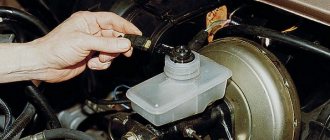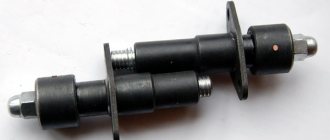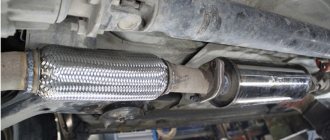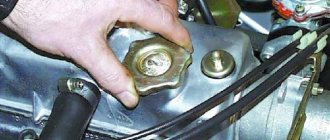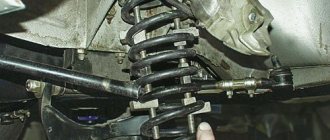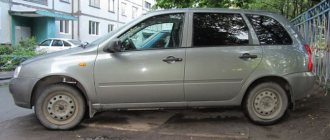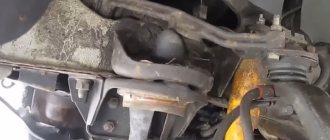Tool:
- Medium flat screwdriver
- Open-end wrench 19 mm
- 17mm curved box spanner
- 19mm straight box spanner
- A special wrench for the shock absorber rod or a 6 mm socket wrench
- Jack or ditch lift
- Punch and hammer (if necessary)
- Hose
Parts and consumables:
Notes:
Perform this work when replacing a shock absorber, compression stroke buffer or spring.
Removing the shock absorber and spring from the rear suspension
1. Place the vehicle on an inspection ditch or overpass.
2. Recline the rear seat back.
3. Use a screwdriver to pry off the plug.
4. Using a 17 mm socket wrench, unscrew the nut of the upper shock absorber mounting, holding the shock absorber rod from turning with a special wrench or a 6 mm socket wrench.
5. Remove the support washer and the upper shock absorber pad.
6. Then raise the rear wheels using a jack or a trench lift.
7. Using a 19 mm wrench, unscrew the nut of the bolt securing the shock absorber to the beam, holding the bolt from turning with a wrench of the same size.
8. Remove the bolt.
Note:
If you have difficulty, knock out the bolt with a soft metal drift.
9. Remove the shock absorber along with the spring.
10. The spring gasket usually sticks to the body, from where it must be removed and ensure that there are no deformations or tears.
11. Remove the spring, lower cushion with bushing, protective cover with cover and compression stroke buffer from the shock absorber.
12. Assemble and install the rear suspension shock absorber in the reverse order.
Rear suspension shock absorber assembly and installation
Note:
For ease of assembly, we recommend attaching the gasket to the spring with adhesive tape or insulating tape, which will make it easier to install it in the body, while the end of the spring coil should rest against the protrusion of the gasket.
1. Place the cover on the cup, and the corrugation of the cover should be put on the flange of the cup.
2. Insert the compression stroke buffer into the case so that its corrugated part is at the bottom.
3. The end of the lower coil of the spring should rest against the protrusion of the shock absorber support.
4. To make installation easier, you can attach a piece of hose to the end of the rod, which will allow you to direct the rod into the hole in the upper support on the body.
5. Install the shock absorber so that the shallower recess of the spring support faces the wheel, with the end of the lower coil of the spring on the left side of the car facing the rear of the car, and on the right facing the front.
6. Secure the lower end of the shock absorber, but do not tighten the nut. When lowering the car onto the wheel or lifting this side of the beam with a jack, insert the end of the shock absorber rod into the hole in the body and secure it. Tighten the lower shock absorber mounting bolt in the “wheel drive” position.
The article is missing:
- High-quality photos of repairs
We carry out the work when replacing a shock absorber, compression stroke buffer or spring. We install the car on an inspection ditch or overpass. Recline the rear seat back. We pry it off with a screwdriver...
...and remove the plug.
Using a 17mm Z-shaped wrench, unscrew the nut of the upper shock absorber mounting, holding the shock absorber rod from turning with a special wrench.
Remove the support washer...
...and a top pillow. We hang up the rear wheels.
Using a 19mm wrench, unscrew the nut of the bolt for the lower shock absorber mounting to the beam, holding the bolt from turning with a wrench of the same size.
We take out the bolt. If there is difficulty, knock out the bolt with a soft metal drift.
We take out the shock absorber along with the spring. The spring gasket usually sticks to the body, from where it must be removed and ensure that there are no deformations or tears.
Remove the spring gasket.
Remove the spring from the shock absorber.
Remove the spacer sleeve with the lower cushion from the rod. Remove the cover with the compression stroke buffer.
We take out the compression stroke buffer from the case.
Remove the cup from the case. We assemble and install the rear suspension shock absorber in the reverse order.
The use of springs in construction
It so happened that the shock absorber and spring come in pairs. This is a one-piece mechanism (in the front part) that provides better ride smoothness and controllability of the machine. To be completely honest, we can note that without springs we would not have experienced such driving comfort, we would have been shaking as if on a cart.
Modern springs do their job remarkably well; manufacturers have learned to adjust the suspension for various needs, be it hard sports, balanced comfortable or off-road.
In any case, the work of the spring comes down to absorbing impacts from the road surface, as well as returning the wheel to its place. And you need to understand that the softer this element is, the greater the impact it can absorb - but the energy (that is absorbed) does not disappear instantly, it is transferred to the body and it sways - if you shake a car without shock absorbers, it will sway for a long time.
The job of the shock absorber is to dampen these “parasitic” vibrations, and the faster the better.
The result is an ideal mixture - the shock goes to the spring, and the vibrations that it has formed are damped by the shock absorber.
By strength
As you understand, these two elements work, as they say, “side by side.” But they have different indicators in terms of strength and wear.
The spring is a very durable element, if you don’t break it on purpose (don’t overload the car), don’t “reckless” the car when entering 90-degree turns at maximum speed, don’t fly into curbs - then it can last a very long time, there were cases when we walked 200 – 300,000 kilometers.
The shock absorber is the weaker part of the suspension, the whole point is that it is much more complex in structure, it has a bunch of O-rings, and there is liquid or gas inside. And damage to one of the elements entails failure of the entire structure. And with our roads and potholes, you can kill him for several thousand (50 - 60). This is not Europe, where they travel 150–200 thousand kilometers.
Accordingly, we change shock absorbers much more often than springs.
Analogs of rear shock absorbers on VAZ 2190 and 2191
The original rear ones are also slightly more expensive than the average price of replacements. Because of this, analogues are also in high demand. The best option would be to purchase rear shock absorber struts in packaging specifically from the manufacturer SAAZ (red box), and not the standard VAZ one (blue), which is true, analogues offer substitutes with slightly better rigidity characteristics and service life.
| Manufacturer | vendor code | price, rub. |
| Sachs | 316763 | 2400 |
| Trialli | AH01510 | 1300 |
| Boge | 30N87A | 2400 |
Sachs 316763
Trialli AH01510
Boge 30N87A
Which shock absorbers for Lada Granta should I choose? Many foreign analogues for the Lada Granta - VAZ 2190/2191 are superior to standard struts in a number of indicators, such as: rigidity, noise level, anti-corrosion coating, and the presence of reinforced mounting of silent blocks. But not all stands have such characteristics, especially if we are talking about a Chinese counterfeit.
The most popular manufacturer of racks among grant providers is SS20. The company specializes in producing racks specifically for Lada cars, including Grants. Therefore, there are no problems with installation, plus their price and quality are more acceptable, except in those rare cases when there are design flaws.
Of course, you can try to purchase Monroe or other spare parts made in Germany or France. But this will be too expensive an option.
What else should you not do?
However, many of our “VAZ DRIVERS” don’t care at all; I’m already silent about the lowered PRIORs. When repairing suspension, and in particular replacing struts, many people prefer not to change other elements, even with high mileage.
I personally witnessed when a guy took the KYB struts, came to the service station, and said, “we leave the springs and support bearings (after a mileage of about 80,000).” Simply - HARD! Guys, turn on your brain. Companies do not always have interchangeable parts, even new ones! That is, you cannot take a KYB strut and install a spring from a VAZ supplier, this is no longer correct, and you are installing a new shock absorber on worn parts!
In the best case, the rack will fail in 10 - 15,000, and then this GUY will shout at every intersection that “I installed KYB, such a g..but!”
In the worst case, there is a possibility that it will fly off the road, because the sagging, tired, corroded “coils” will not be able to properly hold the car and dampen the amplitude of body vibrations. Which negatively affects maximum speeds, cornering, and braking. The body will pull more to the sides during maneuvers.
Therefore, the moral is not to save money, we buy a completely new set.
Will racks fit from Kalina to Granta?
In short, yes, but there are nuances that not everyone knows about. Granta has a slightly different rebound characteristic; the compression stroke buffer is half a centimeter smaller. Hence the lack of knock on the rebound. In all other respects there is no difference, the softness is at the same level, even the holes of the support bearings are the same.
The situation with Priora is somewhat different. If they assure you that the racks are completely suitable, do not believe them and refuse to purchase. Externally they are identical, the only difference is the angle of inclination and centering. In Granta, the stock is offset, in Priora it is strictly in the center. After installing the racks from Priora to Grant, the angle of inclination shifts by 3°. After 500 – 700 km. The wheel bearing will fail due to excessive load on the axle.
Rear suspension
Here the situation is almost the same. Although the suspension design is radically different. Here the shock absorber is not inserted directly into the spring, but comes as if separately. That is, if it is “covered”, it is much easier to replace it! Just unscrew two bolts and remove it, then install a new one.
If you don't haul heavy loads and your vehicle is front-wheel drive (all the weight is in the front), then the rear end will suffer much less. I know from experience that there will be a replacement in 150 - 200 thousand, and maybe more. However, it is advisable to change everything at once.
I hope I helped - sincerely yours, AUTOBLOGGER.
( 8 votes, average: 4.88 out of 5)
Algorithm for self-replacement of rear struts of Lada Granta
A common reason for replacing a rear shock absorber is oil leakage from the cylinder, depressurization, loss of integrity, or seal defects. Less common spring sagging. Tools: open-end wrenches “17, 19”, a set of new struts, WD fluid – 40.
- We fix the front wheels with wheel chocks and engage first gear;
- We fold the back row of seats for ease of maintenance;
- We pry off the rubber plug of the rear glass and remove it;
- Unscrew the upper shock absorber fixing nut;
- Jack up the rear wheel and remove it;
- We hang the side of the car at such a height that the beam has free movement;
- Unscrew the lower fastening, remove the eye from the seat;
- Remove the shock absorber assembly;
- Using a crab puller, compress the spring and remove the boot.
Replacing the Lada Grant strut with a new one, assembling the parts in the reverse order. When moving the rod in the upper position, it will be difficult to get into the hole; an assistant may be needed.
Replacing support bearings without removing the strut
- Jack up the car and remove the wheel;
- Using a crab puller, compress the spring several turns;
- In the engine compartment, unscrew the three nuts securing the support bowl to the glass;
- Unscrew the steering tip and unscrew the nut;
- Lower the shock absorber assembly down;
- We remove the support bowl and replace the Granta strut bearing.
Purpose of springs and shock absorbers
The design of suspensions provides for their overall operation in order to ensure smooth movement and controllability of vehicles. The purpose of the springs is to soften shocks and jolts when hitting any uneven places on the roads. However, at the moment the car wheel hits any obstacle, it, pushing off from it, breaks away from the road surface and becomes uncontrollable. At the same time, the spring compresses and, when released, returns the wheel to the road. It hits the road surface again, and the process repeats again and again.
Typical signs of faulty Lada Granta struts
- the car bounces slightly on uneven surfaces;
- difficulties in driving at medium and high speeds;
- vibrations, beating in the steering wheel when overcoming road obstacles;
- knocking, creaking in the front suspension area;
- decreased ground clearance, sagging springs, roll to one side;
- the piston is filled with oil;
- When you press the wing once, the car continues to swing for some time.
Replacing shock absorbers and when spring replacement is required
The design of shock absorbers is quite complex; they are more likely to break than springs, and, therefore, they need to be replaced periodically. The reasons for the loss of their properties by springs can be:
- natural wear and tear;
- mechanical damage;
- frequent overloading of the car;
- high-speed driving on rough roads;
- fatigue, as well as metal corrosion.
Due to the loss of their properties, sagging of the springs is observed. As a result, the car holds the road worse, its braking performance decreases, shock absorbers wear out faster, etc.
When driving on our roads, shock absorbers require replacement on average after driving 60-80 thousand km. This is where the question arises, what to do with the springs? Especially if it is a front shock absorber spring. Because In modern cars, prefabricated structures with an already inserted spring are installed in the front suspension using MacPherson technology. And new shock absorbers (struts) are sold without them.
Of course, the ideal option is to replace the springs when changing the shock absorbers. However, this is quite expensive and not necessary. After all, with careful driving, the springs can withstand up to 200-300 thousand km. But it is not always possible to determine visually that it has lost its properties.
Therefore, replacing the shock absorber spring (or all springs) is mandatory in the following cases:
- its breakdown;
- obvious metal corrosion or spring damage;
- when there is a decrease in the height of the car or the height of its various parts is not the same.
If the springs are in good condition, we can recommend replacing them during every second shock absorber replacement. Those who mostly drive alone should swap the right and left springs when changing shock absorbers, because In this case, the driver's side of the car bears a large load.
As for the rear suspension, the shock absorbers are separate from the springs (not directly inserted into them). Those. here it is much easier to replace shock absorbers.
You can learn about the basics of proper selection of shock absorbers and springs in our other article. And if it is necessary to replace them, we would recommend using high-quality KAYABA shock absorbers and LESJOFORS car springs.
* Please check the applicability of parts specifically for your car with our managers by phone (calls within Russia are free).
| Manufacturer | vendor code | Name | Applicability* |
| KAYABA | RA1818 | Suspension spring | FORD Fusion station wagon (JU_) |
| KAYABA | RG3405 | Suspension spring | FORD FOCUS II - 1.8 |
| KAYABA | RG3404 | Suspension spring | FORD FOCUS II sedan |
| KAYABA | RA6655 | Suspension spring | FORD FOCUS II - 1.8 |
| KAYABA | RA5306 | Suspension spring | FORD MAVERICK 5 DOOR - 2.4 / 2.7 TD |
| KAYABA | RH2634 | Suspension spring | FORD Mondeo sedan III (B4Y) |
| KAYABA | RH3311 | Front suspension spring | NISSAN Note (E11) |
| KAYABA | RC5868 | Suspension spring | NISSAN Almera sedan II (N16E) |
| KAYABA | RC3430 | Front suspension spring | MAZDA Mazda3 sedan (BK) |
| KAYABA | RA5305 | Suspension spring | FORD MAVERICK 5 DOOR - 2.4 / 2.7 TD |
| Lesjofors | 8092501 | Suspension spring | TOYOTA CAMRY 1/06- |
| Lesjofors | 4285733 | Rear suspension spring | SKODA Yeti |
| Lesjofors | 4027602 | Suspension spring | FORD FOCUS 2 |
| Lesjofors | 4027603 | Suspension spring | FORD FOCUS 2 |
| Lesjofors | 4215628 | Rear spring reinforced | MITSUBISHI OUTLANDER II |
| Lesjofors | 4066775 | Suspension spring | PEUGEOT BOXER |
| Lesjofors | 4288343 | Rear suspension spring | SUBARU Impreza hatchback III (GR) |
| Lesjofors | 4247013 | Rear spring | LADA LARGUS |
| Lesjofors | 4285734 | Rear suspension spring | SKODA Yeti |
| Lesjofors | 4235758 | Rear spring | HONDA CR-V III |
All of the shock absorbers and shock absorber springs listed above can be purchased at IXORA stores. Our qualified managers will always provide assistance in their choice.
By the way, do you know how to distinguish an original shock absorber from a fake? You will find some tips for such a check in the video below.
Cost of equipment for tuning Lada Grants
Lowered suspension on Grant
| Name | Price, rub.) |
| Air suspension Aride 01020 | 35000 – 55000 service station services: 5 – 10 thousand. |
| Shock absorbers with mechanical adjuster Aride 01023 | 18000 – 24000 service station services: 3 – 5 thousand. |
| Set of short springs, shock absorbers with limited travel SS20 Racing KIT PRO Sport 986565, 984144 | shock absorber from 2500 – 2800 two front ones from 4000 two rear from 4300 service station services: 5.0 thousand. |
| Low profile tiresR15 R16 Strial St 401 195/50 R15 82V Triangle TE301 195/50 R15 82V Achilles ATR Sport 195/45 R16 84V Tigar High Performance 195/45 R16 84V XL BFGoodrich g-Grip 195/45 R16 84V XL | from 2600 – 3200 service station services: the cost of re-shoes is negotiated individually |
| Short springs Tehnoressor 598259898, 546435443 (- 30 mm) 1000005950 (- 50 mm) | from 1300 service station services: individually |
| Trimming factory springs | independently free service station services: individually |
| Shock Absorber Kits ASTON: understatement (-50) - (-140) Demfi: (-30) - (-90) Techno Spring: (-30) — (-120) | From 2900 to 3700 Depending on the place of purchase |
Related link:
Replacing the rear light of a Lada Granta liftback without a service station. Advice from experienced people
*prices are current as of October 19, 2018.
Helpful information:
You can get professional advice when selecting a product by calling 8 (calls within Russia are free).
Many car owners have already encountered, probably more than once, suspension malfunctions. Some elements of this system fail much earlier than manufacturers promise. Are the latter really deceiving consumers? Maybe. But do not forget that one of the main reasons for the occurrence of such breakdowns is the unsatisfactory condition of domestic roads.
Let's not continue this topic. After all, you are not reading this material for this, but in order to figure it out and understand whether it is necessary to change the springs along with the shock absorbers.
Analogs of front shock absorbers VAZ 2190 and 2191
Many car owners prefer foreign analogues, which are superior in quality and more attractive in price. But even here, not everything is so simple - when going to the car market, you should beware of Chinese counterfeits, both domestic and foreign spare parts.
The most popular shock absorber struts among car enthusiasts are shown in the table:
| Manufacturer | vendor code | price, rub. |
| Pilenga | SHP2791O (left) | 1400 |
| Pilenga | SHP2790O (right) | 1400 |
| SS20 | SS20194 (set of 2 pieces) | 3000 |
SS20 SS20194
Pilenga SHP27910
If necessary?
To put everything into perspective, let’s remember what tasks are performed by springs and what tasks are performed by shock absorbers. Very short so as not to waste time on unnecessary details.
So let's start with the springs. They are responsible for softening shocks and shocks when you drive on uneven roads. When the car overcomes another obstacle on a rough road, the wheel leaves the ground and thus becomes uncontrollable in that short moment. The spring returns it to its place. But she is unable to stop the oscillations that the wheel will continue to make for some time. This is where the shock absorber comes into play. It is shock absorbers that are designed to quickly dampen wheel vibrations and convert them into thermal energy.
For reference: a conventional shock absorber that does not have faults absorbs and converts up to 80% of the energy after 1 wheel vibration.
Thus, it is possible to ensure normal operation of the suspension only in one case. When both shock absorbers and springs fully perform their functions.
Spring with shock absorber
Let's consider another point. In fact, springs are responsible for maintaining the weight of the car, and shock absorbers are responsible for controlling their movements. Right? Am I missing anything? Now imagine the following. One of the springs begins to sag. The shock absorber working with this spring receives additional load and fails prematurely. As a result, we get the car rocking. That is, the shock absorber and spring directly depend on each other.
The spring loses its original properties for four main reasons, which you probably already know:
- material fatigue;
- damaged spring surface;
- frequent overloads;
- corrosion.
By the way, the braking performance of the car also depends on the condition of the springs. What have I been leading to all this time?
Catalog articles for factory front/rear struts of Lada Granta
Standard dimensions of the front struts: rod diameter 220 mm, body diameter 520 mm, rod free play 1700 mm, height 3450 mm. Grant rear struts: rod diameter 125 mm, cylinder body 425 mm, weight 2.00 kg, oil volume 0.56 liters.
| Installation location | Article / OEM / index |
| Front left | 219002905402 |
| —/— | 219002905403 |
| —/— | k190.2905.002-05 |
| —/— | 21900290103100 |
| —/— | 21928290103110 |
| Front right | 21900290103000 |
| —/— | 21928290103010 |
| —/— | 21900290103010 |
| —/— | k190.2905.003-05 |
| Rear left/right | 21900291500400 |
The specified shock absorber articles are intended for installation on Lada Granta of all modifications starting from 2011: 21906-40, 21911-40, 21917-42, 21917-41, 21901-41.
Note to the driver. For the Lada Granta Sport, other struts are available, with a shortened rod stroke. Gas is used instead of oil filler. Catalog number: A190291500440.
“The best option is to replace the springs along with the shock absorbers!”
Are you saying that this is a very expensive business? Why is it difficult to identify some of the features described above? Your desire to save is clear as day, it is natural. Now look. Without changing the springs, you have actually reduced the life of the shock absorbers by 2 times. Have you calculated how much money you will have to spend as a result? That's it. By changing springs along with shock absorbers, you save money rather than spend extra money.
If there are no problems with the springs, the reasons for which are described above, then it is permissible to replace the spring with every 2nd replacement of the shock absorber.
You also need to know 4 main situations when springs ALWAYS need to be changed:
- if the spring is simply broken;
- if corrosion/damage to the metal is detected;
- if you find a difference in the height of the front and rear parts of the car;
- if a decrease in vehicle height is detected (when compared with the technical description; to check, you will have to measure the distance between the center of the wheel and the edge of the arch on each wheel).
Reminder! Do not create an imbalance in the suspension and replace the springs in pairs per axle.
